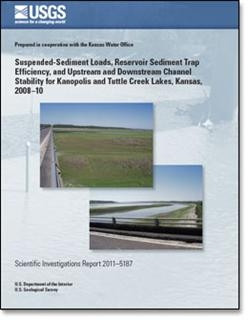
Product Details
- Product Number
- 322234
- Series
- SIR-2011-5187
- Scale
- NO SCALE
- Alternate ID
- SIR-2011-5187
- ISBN
- 978-1-4113-3278-2
- Authors
- KYLE E JURACEK
- Version Date
- 11/01/2011
- Regions
- KS
- Countries
- USA
- Media
- Paper
- Format
- Bound
Additional Details
- Description
- Abstract Continuous streamflow and turbidity data collected from October 1, 2008, to September 30, 2010, at streamgage sites upstream and downstream from Kanopolis and Tuttle Creek Lakes, Kansas, were used to compute the total suspended-sediment load delivered to and released from each reservoir as well as the sediment trap efficiency for each reservoir. Ongoing sedimentation is decreasing the ability of the reservoirs to serve several purposes including flood control, water supply, and recreation. River channel stability upstream and downstream from the reservoirs was assessed using historical streamgage information. For Kanopolis Lake, the total 2-year inflow suspended-sediment load was computed to be 600 million pounds. Most of the suspended-sediment load was delivered during short-term, high-discharge periods. The total 2-year outflow suspended-sediment load was computed to be 31 million pounds. Sediment trap efficiency for the reservoir was estimated to be 95 percent. The mean annual suspended-sediment yield from the upstream basin was estimated to be 129,000 pounds per square mile per year. No pronounced changes in channel width were evident at five streamgage sites located upstream from the reservoir. At the Ellsworth streamgage site, located upstream from the reservoir, long-term channel-bed aggradation was followed by a period of stability. Current (2010) conditions at five streamgages located upstream from the reservoir were typified by channel-bed stability. At the Langley streamgage site, located immediately downstream from the reservoir, the channel bed degraded 6.15 feet from 1948 to 2010. For Tuttle Creek Lake, the total 2-year inflow suspended-sediment load was computed to be 13.3 billion pounds. Most of the suspended-sediment load was delivered during short-term, high-discharge periods. The total 2-year outflow suspended-sediment load was computed to be 327 million pounds. Sediment trap efficiency for the reservoir was estimated to be 98 percent. The mean annual suspended-sediment yield from the upstream basin was estimated to be 691,000 pounds per square mile per year. In general, no pronounced changes in channel width were evident at six streamgage sites located upstream from the reservoir. At the Barnes and Marysville streamgage sites, located upstream from the reservoir, long-term channel-bed degradation followed by stability was indicated. At the Frankfort streamgage site, located upstream from the reservoir, channel-bed aggradation of 1.65 feet from 1969 to 1989 followed by channel-bed degradation of 2.4 feet from 1989 to 2010 was indicated and may represent the passage of a sediment pulse caused by historical disturbances (for example, channelization) in the upstream basin. With the exception of the Frankfort streamgage site, current (2010) conditions at four streamgages located upstream from the reservoir were typified by channel-bed stability. At the Manhattan streamgage site, located downstream from the reservoir, high-flow releases associated with the 1993 flood widened the channel about 60 feet (30 percent). The channel bed at this site degraded 4.2 feet from 1960 to 1998 and since has been relatively stable. For the purpose of computing suspended-sediment concentration and load, the use of turbidity data in a regression model can provide more reliable and reproducible estimates than a regression model that uses discharge as the sole independent variable. Moreover, the use of discharge only to compute suspended-sediment concentration and load may result in overprediction. Stream channel banks, compared to channel beds, likely are a more important source of sediment to Kanopolis and Tuttle Creek Lakes from the upstream basins. Other sediment sources include surface-soil erosion in the basins and shoreline erosion in the reservoirs.
- Survey Date
- 2011
- Print Date
- 2011
- Height In Inches
- 11.000
- Length In Inches
- 8.500
- Two Sided
- Yes
- Pieces
- 1
- Languages
- English
Related Items



